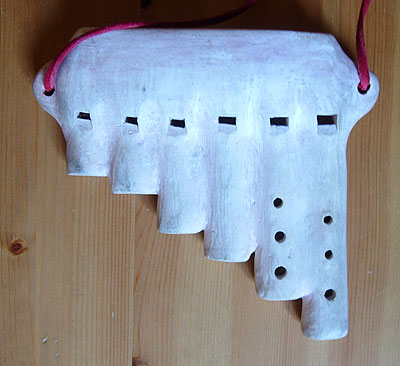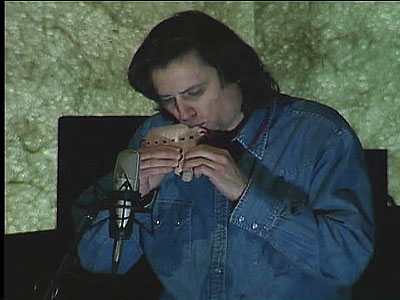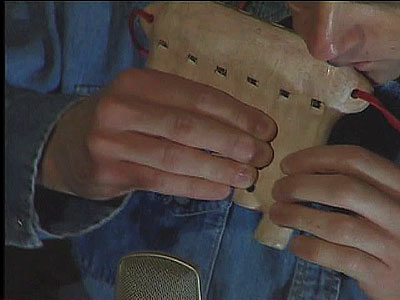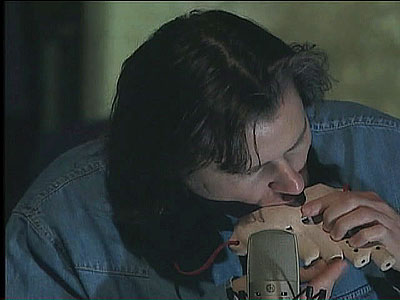
In this post we're going to look at a very unusual flute. A Zapotec clay flute & whistle. At first glance this instrument appears to be what many would call a Pan-Pipe or a
Zampoña as is used in the musical cultures of the Andes. Rather it is a combination of four
whistles and two small flutes joined together. A whistle is just a flute that plays one note, however as we'll see below, by covering the opening at the bottom of the tube another note can be played. All of these use a
fipple to produce their sound.
Construction and Scales
This instrument is made from clay and has a white slip. The length across the top mouth piece is 4-1/4". The longest flute is 5-1/2" while the shortest whistle is 2-1/2" Like the Native American flutes discussed before, longer flutes play lower pitches. So is should come as no surprise that the longest flute on the right plays the lowest notes. These notes starting with all holes covered, including a thumb hole on the back, are C#, E, F#, G# and A. The flute to it's left plays D#, F#, G# and A#. There is no thumb hole for this flute.

The whistles can each play two notes. A higher pitch by just blowing through the mouthpiece, and a lower pitch by covering, or "stopping", the hole at the end of the pipe. Stopping the pipe causes the sound waves to travel twice the length of the pipe, thus lowering the pitch. The player alternates between the lower and higher pitch by covering and uncovering the end of the pipe. The notes the whistles on this instrument play are, from right to left, B/F, C#/G#, E/B, and G/C#. I use the whistles for color rather than as a melodic instrument, the notes available being somewhat limited. Two of the whistles play a diminished 5th (augmented fourth), or a
Tritone which was once called the
diabolus in musica ("Devil's interval") in early Western music up to the baroque period. This is a very dissonant interval and it is not found in the Native American flute's Pentatonic scale. These whistles, however, make excellent bird sounds. Examples of this can be heard in Heart of the Sky from New Fire and in the sample below.
The flutes can also be "stopped", by covering the holes at their ends, with all finger holes covered. When stopped they play a pitch that is a 5th lower than the lowest note played when not stopped. The longer flute on the right for example plays a F# when stopped, a 5th lower than it's un-stopped C#. This produces an extended scale. This extended scale is F#, C#, E, F#, G# and A. The flute to it's left will play a G# when stopped making it's extended scale G#, D#, F#, G# and A#. Notice how the lower five intervals are the same for both flutes and the first four intervals are found in the NAF Pentatonic scale.
The Maker
The maker of this flute is named Nashtavewa or Nash. He is from a
Zapotec village named "Ltavehua" located in the jungle forest on the southeast coast of Mexico in the
Oaxaca region. According to his bio his parents "are traditional artists specializing in clay whistles, authentic Zapotec cookware and traditional Zapotec ceremonial figures. He currently lives in Orange County. I met him originally at a southern California flute circle meeting at Guillermo Martinez’s (of
Quetzalcoatl Flutes & Drums) house. Nash was studying with Guillermo and had some clay flutes for sale. As he doesn't have a web site, I am always interested to see if he has something I like. In addition to the flute featured in this post I also have three wind chambers and several bird whistles made by him and use them extensively. Nash also makes a replica of the Aztec Death Whistle which can be purchased through the
Oregon Flute Store.
LISTEN TO A SAMPLE OF THIS FLUTE




